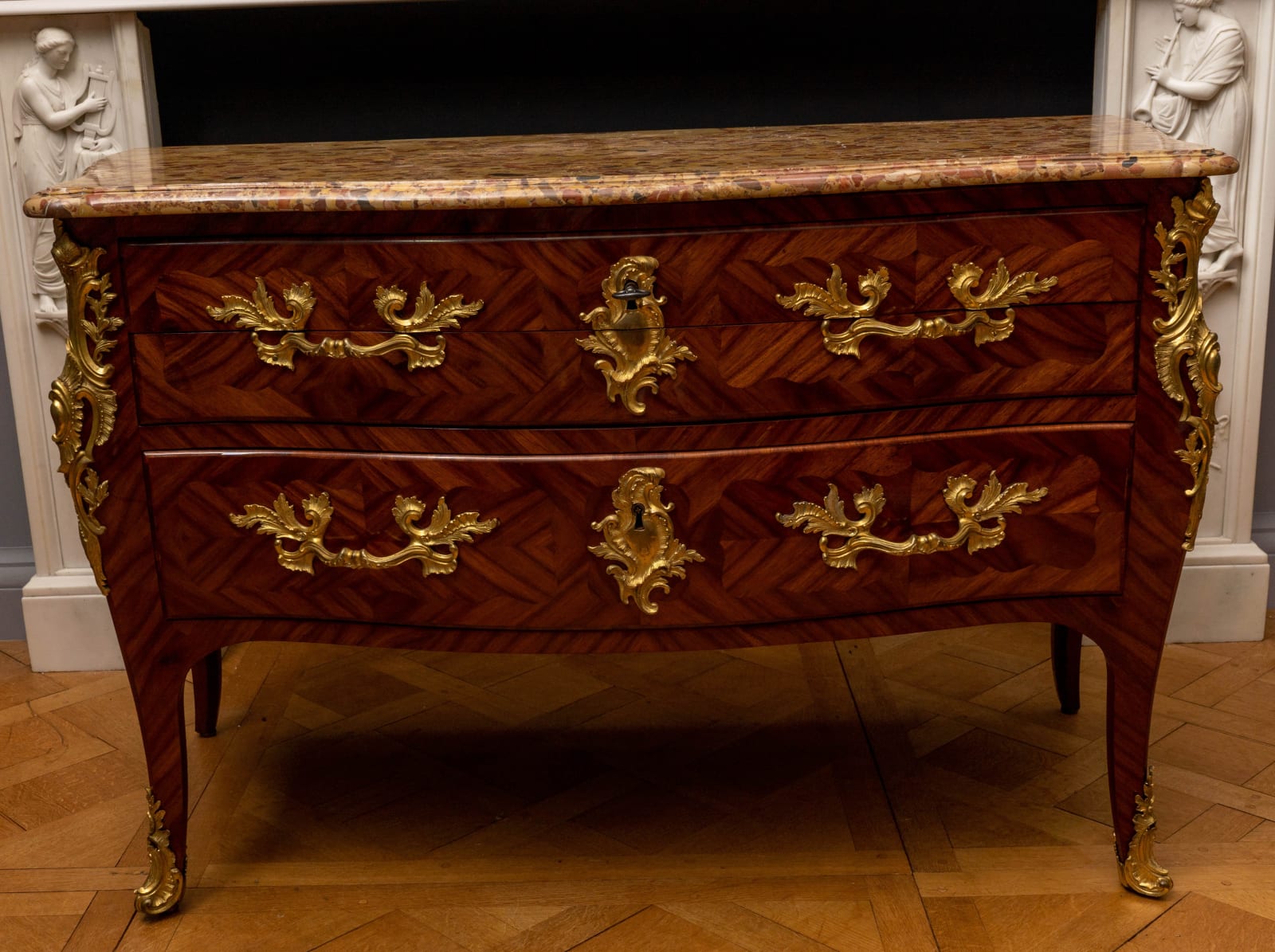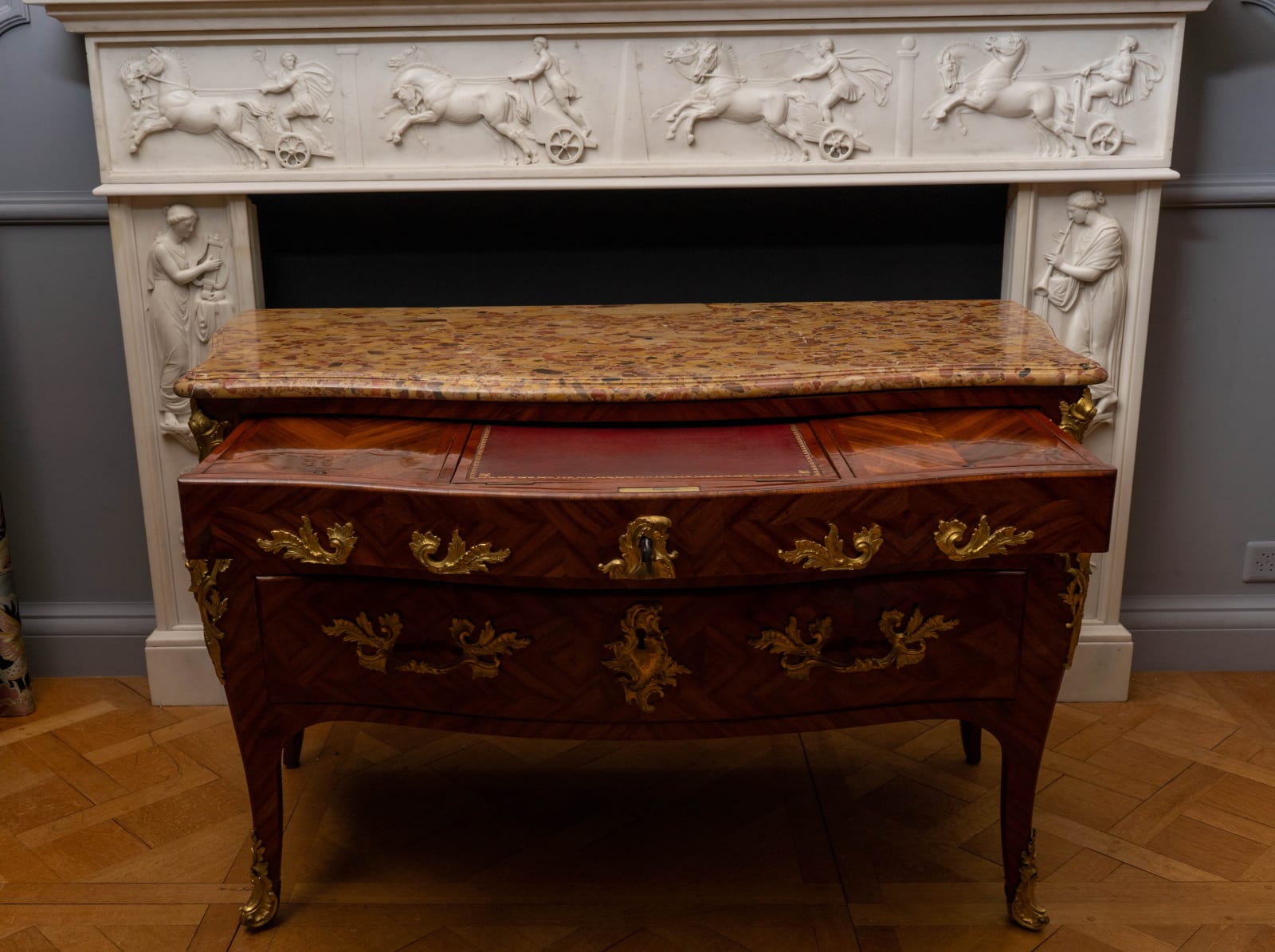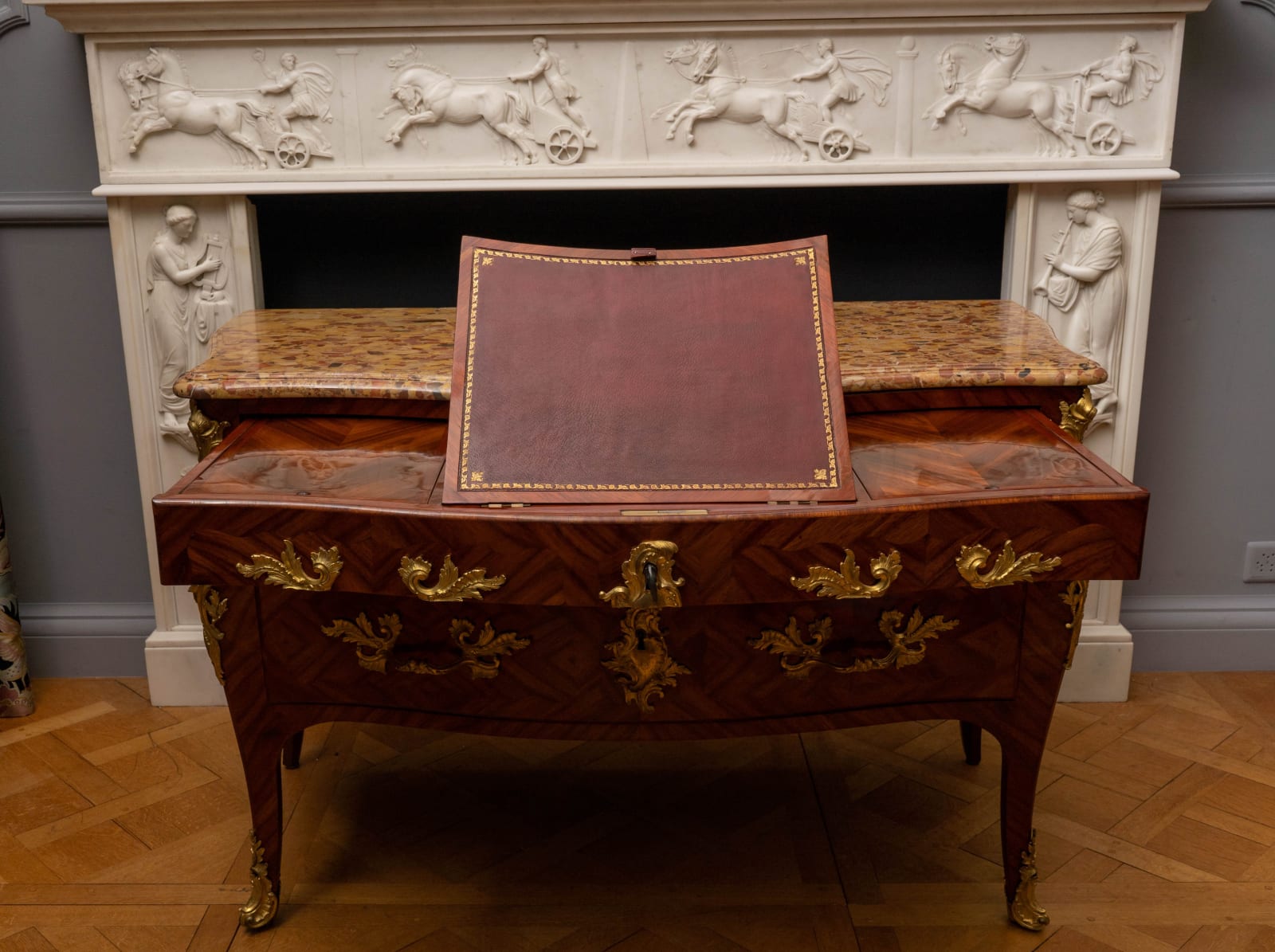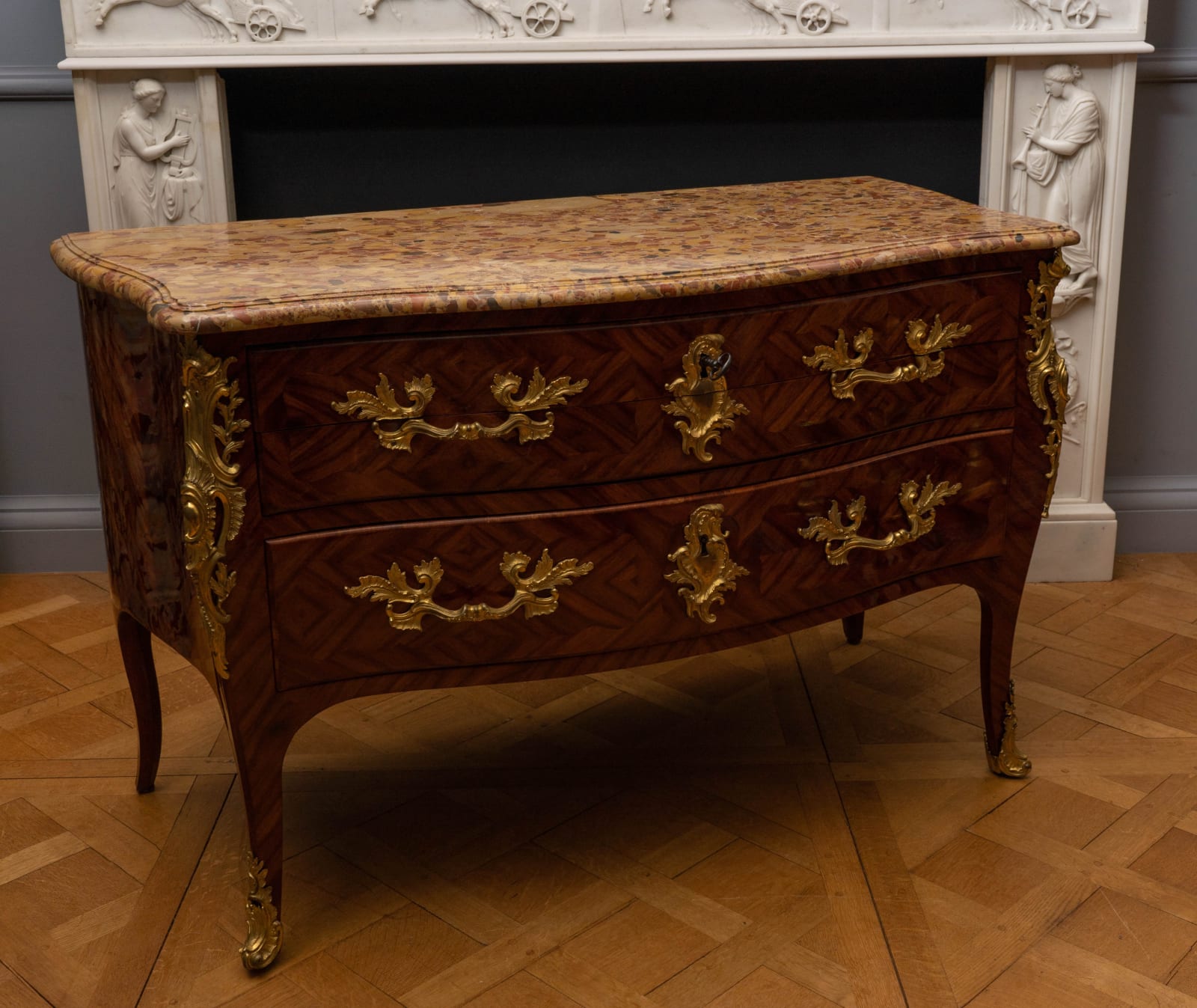Pierre IV Migeon
A LOUIS XV GILT BRONZE MOUNTED BOIS DE SATINÉ COMMODE EN SECRÉTAIRE, Paris, date circa 1750-55
Height 82cm, width 130cm, depth 60cm
Further images
A very rare and superb quality Louis XV gilt bronze mounted bombé bois de satiné parquetry commode en secrétaire by Pierre IV Migeon, stamped MIGEON twice on the top, the brèche d’Alep marble serpentine-shaped rectangular top above two drawers, with the upper drawer divided into two but with a continuous border around the top and sides as if they were one drawer above a single lower drawer, with a conforming border around its sides and base, the divided upper drawer with a single central C-scrolled rocaille escutcheon flanked by elaborate foliate handles, the lower drawer with conforming escutcheon and handles, the upper part of the top drawer opening to reveal a central gilt-tooled red leather-inset writing surface which can be adjusted to become a reading-stand, flanked by a pair of large stationery wells, each with a fitted sliding veneered lid, the angles ornamented with scrolled rocaille mounts, supported on cabriole legs terminated by scrolled foliate rocaille sabots.
Paris, date circa 1750-55
Height 82 cm, width 130 cm, depth 60 cm.
Provenance: René Fribourg (1880-1963). Sold from The René Fribourg Collection, Sotheby’s London, 18th October 1963, lot 801. Chalom of Paris, almost certainly Maurice Chalom, purchased from the Fribourg sale for £2,900.
Literature: The Times, 19th October 1963, p. 10, “Among notable pieces of furniture…. Chalom gave £2,900 for a secretaire-commode by Migeon”. Sophie Mouquin, “Pierre IV Migeon”, 2001, p. 117, illustrating a similar commode en secrétaire by Pierre IV Migeon.
This remarkable piece of furniture, which on first impression looks like a typical Louis XV commode, also includes within the top drawer a central adjustable writing surface come reading-stand flanked by two compartments with finely veneered lids for storing stationery. It is a very rare piece being one of a limited number of commodes en secrétaire made during Louis XV’s reign. Another very similar kingwood and parquetry commode en secrétaire by Pierre IV Migeon (1696-1758) was acquired by a private collector from the Paris dealer Maurice Segoura and sold at Christie’s New York, 24th May 2000, lot 314. The latter, of the same overall form as here but with three distinct drawers and looped handles above a gilt bronze mounted apron, featuring the exact same arrangement in the top drawer with its adjustable reading-stand and flanking covered stationery wells. Another commode en secrétaire with abundant mounts and trellis-parquetry veneers was sold from an anonymous private collection at Christie’s Monaco, 5th December 1992, lot 62. Added to them is further example with cube marquetry veneer and two drawers, known from the archives of Galerie Wanecq, Paris and illustrated in Sophie Mouquin’s book on Pierre IV Migeon, op. cit.
Sophie Mouquin’s research into the life of the Migeons, a celebrated Protestant family of Parisian ébénistes, discusses how Pierre IV Migeon, the maker of this commode en secrétaire, is in fact the same ébéniste as the one formerly referred to as Pierre II Migeon. Pierre IV Migeon produced furniture of outstanding quality which was destined for a wide range of prestigious clientele and as Mouquin notes, occupies a place on the top tier of Parisian cabinetmaking during the first half of the eighteenth century. He also acted a marchand-ébéniste, proving extremely influential on the tastes of his clients. Pierre IV Migeon belonged to a renowned dynasty of ébénistes and was one of the most important artisans in the Faubourg Saint-Antoine, the traditional quarter for Parisian cabinetmakers. Born on 13th August 1696, he was the son of Judith née Mesureur and the ébéniste Pierre III Migeon (1665-c.1717) and grandson of Pierre I Migeon (active c. 1637), the founder of this famous family of cabinetmakers. By his short lived marriage to Madeleine Horry in 1732, Pierre IV had a son, also named Pierre who now known as Pierre V Migeon (1733-75), was in turn to follow the family trade.
Having worked and trained under his father Pierre III, Pierre IV Migeon was received as a maître-ébéniste sometime before 1729. Ten years later and having already proved his prowess in his field he was firmly established as head of the family workshop and furniture emporium at rue de Charenton in the Faubourg Saint-Antoine. The firm’s day-book from 1730-36 reflects an extremely prosperous concern whose clientele included the dowager duchess de Bourbon, the duc d’Orleans son of the Regent and the duchesse de Rohan for whom Migeon supplied one of the first executed secrétaires en armoire in 1731. In addition, he is known to have worked for the Garde Meuble de la Couronne as well as the Prince du Sang and other members of the French aristocracy. Most notable among them was the duc de Boufflers, the duc de Brancas and the duc de Noailles as well as Louis-Adelaïde d’Orléans and Mme de Pompadour. He also supplied high profile political and financial figures in France, leading members of the church as well as ambassadors and foreign princes.
From an early stage in his career Pierre IV Migeon began acting as a retailer as well as a maker of furniture, sub-contracting work as a marchand-ébéniste to his contemporaries, some of whom may have lacked access to a private clientele. The fact that he worked both as an ébéniste and dealer also helps account for the large number of pieces that bear his mark, sometimes with his stamp appearing beside or near that of the actual maker, as is the case of the bureau ‘de Vergennes’ now in the Musée du Louvre, which alongside Migeon’s own stamp bears that of Jacques Dubois. Among many of the finest ébénistes who supplied him with pieces were men such as Léonard Boudin, Jacques Bircklé, Roger Vandercruse, Charles Topino, Gérard Péridiez, Mathieu Criaerd and others. Despite the large number of suppliers, pieces bearing Migeon’s stamp share a striking stylistic uniformity. His designs were restrained and never excessively rococo, though his work showed a preference to serpentine shapes and sometimes rather robust forms such as his commodes en tombeaux and low secrétaires. As here his veneers were restrained but infinitely intricate, often featuring geometric patterns, sometimes incorporating florally decorative cartouches and usually using deep toned woods such as bois de satiné, kingwood or tulipwood. In addition, Migeon’s pieces are occasionally decorated with lacquer work and rare Vernis Martin.
Among Pierre II’s Migeon’s specialities were commodes, secrétaires, bureaux and small pieces with elaborate fittings such as luxurious water closets, supplied to the ladies of court including Mme de Pompadour. The latter was an important client for whom he made encoignures and a night table for her apartment at Marly as well as bidets and his speciality, the commode chair. From 1740 Migeon supplied the court through the offices of the Menus Plaisirs and also provided various functional pieces to the Garde-Meuble de la Couronne, who were responsible for furnishing the royal palaces. Following Pierre IV’s death in 1758, his flourishing business was continued by his son Pierre V Migeon (maître 1761) up until his own death in 1775. Thereafter and for the next decade the business was continued by Pierre V’s widow Marie-Anne (daughter of the maître menuisier Abraham Guerne), whom he had married relatively late in in life, in 1762.
Work by all members of the family is of the very finest quality. Pieces by Pierre IV Migeon can be seen in at the Musées des Arts Décoratifs, du Louvre, Petit Palais and de Carnavalet in Paris; at the Châteaux de Fontainebleau and Champs-sur-Marne as well as the Musée des Arts Décoratifs in Lyon and at Beauvais. His work is also prized among the collections at the Victoria and Albert Museum and the Wallace Collection in London as well as at Waddesdon Manor in Buckinghamshire, the National Gallery of Art in Washington and the Residenzmuseum in Munich.
Not only a rare work of outstanding quality, Migeon’s commode en secrétaire was once in the celebrated collection belonging to Rene Fribourg (1880-1963) who was a consummate collector with a penchant for eighteenth century works of art. Following his death, a series of seven remarkable sales were held by Sotheby’s London during 1963. The auctions caused a sensation and were widely reported in the press, among them was The Times newspaper who on February 16th1963, p. 10, noted “the great collection of eighteenth century art – paintings, drawings, furniture and silver etc – formed by the late Rene Fribourg, who died in New York at the age of 82. Mr Fribourg, whose family business was founded at Arlon in Belgium as long ago as 1813, moved to New York in 1940. He was the founder and chairman of the Continental Grain Company. The collection will be dispersed in seven separate sales, one of them confined to gold boxes and other small objets d’art, one to paintings, one to drawings, two to porcelain and two to furniture. French silver, tapestries, and bronzes will be dealt with at other sales which will include properties belonging to other owners. Mr Fribourg made many gifts to museums, both in Europe and in the United States, and his collection is said to be the most important of its kind to come onto the international market for at least 25 years.”
This piece was later singled out by a Times reporter among notable pieces sold in the final sale on 18th October, where it was noted that it had been bought by Chalom of Paris, who was almost certainly the dealer Maurice Chalom. In that same sale alone were other Louis XV gems including a marquetry table by Lacroix, chairs by Louis Charles Carpentier, a pair of porcelain mounted secrétaires attributed to Martin Carlin as well as three-tier centre table by Charles Topino. Fribourg, who like his great grandfather Simon Fribourg (b. 1780), the founder of the family firm, was born in Arlon in Belgium. It was there that Simon Fribourg had first begun trading in grains; by the mid nineteenth century his family firm had also begun building mills in Belgium as well as in Luxembourg and Holland, enabling them to transport flour and wheat throughout Europe. In time they also began trading in the Baltic and established branches in London and America. When in 1920 the firm’s headquarters moved to Paris it was renamed Companie Continentale, at which period Rene was living in Paris. However, with the German invasion during World War II he was forced to flee to America, where he and his brother Jules (1877-1944) had already set up the company’s first US Continental Grain Company branch in Chicago in 1921, followed by another branch in New York. In 1946 Rene Fribourg married Leah Kuba (1892-1970) in Connecticut and having filed for American citizenship in 1948, he lived for many years at 11 East 84th Street, New York. Never forgetting his European roots and armed with a discriminating eye as well as ample finances to support his passion, he was able to build up his remarkable art collection, counting among it this magnificent piece.
1
of
24







